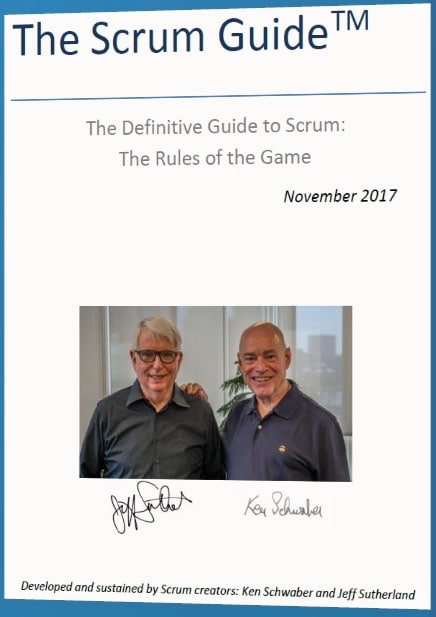
Le Scrum Guide a dernièrement reçu une mise à jour en Novembre 2017. Avant que ne sorte la version officiellement traduite en français, je vous propose une première traduction des changements opérés entre 2016 et 2017 ainsi que des paragraphes concernés.
Les thèmes principaux abordés sont :
- Les usages de Scrum
- Un affinage du rôle de Scrum Master
- Des précisions sur le Daily Scrum, des Time-boxes et du Sprint Backlog
Note : vous pouvez retrouver l’information originale dans les révisions de Scrum.
1. Les usages de Scrum
Scrum a été initialement développé pour gérer et développer des produits. Né au début des années 90s, Scrum a été largement utilisé dans le monde entier, pour :
- Rechercher et identifier les marchés viables, les technologies et les capacités produit;
- Développer des produits et des améliorations;
- Livrer des produits et des améliorations, plusieurs fois par jour;
- Développer et soutenir le Cloud (en ligne, sécurisé, à la demande) et d’autres environnements opérationnels pour l’usage de produit; et,
- Entretenir et renouveler les produits.
Scrum a été utilisé pour développer des logiciels, du hardware, des logiciels embarqués, des réseaux de fonctions en interaction, des véhicules autonomes, des écoles, des gouvernements, du marketing, gérant les opérations d’organisations et presque tout ce que l’on utilise dans notre vie quotidienne, en tant qu’individus ou sociétés.
Comme la technologie, le marche, et les complexités environnementales et leurs interactions ont rapidement augmenté, l’utilité de Scrum dans sa gestion de la complexité est prouvée jour après jour. Scrum s’est avéré spécialement efficace dans le transfert itératif et incrémental de connaissances. Scrum est à présent largement utilisé pour des produits, services, et la gestion de l’organisation parente. L’essence de Scrum est une petite équipe de personne. L’équipe individuelle est grandement flexible et adaptable. Ces forces continuent à opérer seules, à plusieurs, et dans des réseaux d’équipes qui développent, livrent, opèrent et entretiennent le travail et les produits de milliers de personnes. Il collaborent et inter-opèrent dans des architectures de développement sophistiquées et des environnements de livraisons cibles.
Lorsque les mots « développer » et « développement » sont utilisés dans le Scrum Guide, ils se refèrent au travail complexe, tels que ces types identifiés ci-dessus.
2. Le rôle de Scrum Master
Le texte décrit maintenant :
Le Scrum Master est responsable de la promotion et du soutien de Scrum comme défini dans le Scrum Guide. Les Scrum Masters font cela en aidant tout le monde à comprendre la théorie, les pratiques, les règles, et les valeurs de Scrum.
Le Scrum Master est un leader-serviteur pour l’Équipe Scrum. Le Scrum Master aide ceux en dehors de l’Équipe Scrum à comprendre les interactions – avec l’Équipe Scrum – qui sont utiles et celles qui ne le sont pas. Le Scrum Master aide tout le monde à changer ces interactions pour maximiser la valeur créée par l’Équipe Scrum.
3. Le Scrum Master au service du Product Owner
Ajout de :
Il s’assure que les objectifs, le périmètre, et le domaine produit soient compris par tout le monde dans l’Équipe Scrum aussi bien que possible.
4. Daily Scrum – Mêlée quotidienne
Mise à jour du premier paragraphe :
La Mêlée quotidienne est un événement time-boxé à 15 minutes pour l’Équipe de Développement. La Mêlée quotidienne a lieu tous les jours du Sprint au cours de laquelle l’Équipe de Développement planifie le travail pour les prochaines 24 heures. Cela optimise la collaboration et la performance de l’équipe en inspectant le travail depuis la dernière Mêlée quotidienne et en prévoyant le travail du prochain Sprint. La Mêlée quotidienne a lieu à la même heure et au même endroit chaque jour pour réduire la complexité.
5. Objectifs de la Mêlée quotidienne
La structure de la réunion est définie par l’Équipe de Développement et peut être conduite de différentes manières si elle se focalise sur la progression vers l’Objectif de Sprint. Certaines Équipes de Développement utiliseront des questions, d’autres seront plus basées sur des discussions. Voici un exemple de ce qui pourrait être utilisé :
- Qu’ai-je fait hier qui a aidé l’Équipe de Développement à atteindre l’Objectif de Sprint ?
- Que vais-je faire aujourd’hui pour aider l’Équipe de Développement à atteindre l’Objectif de Sprint ?
- Est-ce que je vois des impedimentas m’empêchant moi ou l’Équipe de Développement d’atteindre l’Objectif de Sprint ?
6. Time-Boxes
Utilisation des mots « au maximum » pour enlever toute question sur le fait que la time-box pour les Événements signifie longueur maximale, mais peut être plus courte.
7. Sprint Backlog
Pour assurer l’amélioration continue, il inclut au moins un élément de haute priorité sur la manière dont l’équipe va travailler, identifiée dans la réunion de Rétrospective précédente.
8. Incrément
Un incrément est un ensemble inspectable de travail « Terminé » qui supporte l’empirisme à la fin du Sprint. L’incrément est un pas vers la vision ou l’objectif.
Ressource supplémentaire
Un article (eng) de Stacey Louie résumant les mises à jour du Scrum Guide 2017.






